A SWOT Analysis for Offshore Wind Energy Assessment Using Remote-Sensing Potential
Abstract
1. Introduction
1.1. Synthetic Aperture Radar (SAR) Satellites
1.2. ECMWF Reanalysis
2. Case Studies
3. Material and Methods
3.1. Satellites and Reanalysis Analysis
3.2. SWOT Analysis
4. Results
4.1. Remote Sensing Techniques
4.2. Potential Assessment
5. Discussion
6. Conclusions
Author Contributions
Funding
Acknowledgments
Conflicts of Interest
Abbreviations
| RS | Remote sensing |
| SWOT | Strengths, weaknesses, opportunities and threats |
| RESs | Renewable energy sources |
| MREs | Marine renewable energies |
| OW | Offshore wind |
| WEGs | Wind turbine generators |
| WECs | Wave energy converters |
| SAR | Synthetic aperture radar |
| ECMWF | European center for medium-range weather forecasts |
| ESA | European space agency |
| MWS | Mean wind speed |
| WPD | Wind energy density |
| SWH | Significant wave height |
| SCS | Sea current speed |
| SNAP software | Sentinel application platform |
| ENVI software | Environment for visualizing images |
| ROI | Region of interest |
| GIS | Geographic information system |
| VV | Vertical vertical |
| CMOD | C geophysical model function |
References
- Heydari, A.; Astiaso Garcia, D.; Keynia, F.; Bisegna, F.; De Santoli, D. Renewable Energies Generation and Carbon Dioxide Emission Forecasting in Microgrids and National Grids using GRNN-GWO Methodology. Energy Procedia 2019, 159, 154–159. [Google Scholar] [CrossRef]
- Neshat, M.; Nezhad, M.M.; Abbasnejad, E.; Groppi, D.; Heydari, A.; Garcia, D.A.; Tjernberg, L.B.; Alexander, B.; Wagner, M. Hybrid Neuro-Evolutionary Method for Predicting Wind Turbine Power Output. arXiv 2020, arXiv:2004.12794. [Google Scholar]
- Lamagna, M.; Nastasi, B.; Groppi, D.; Nezhad, M.M.; Astiaso Garcia, D. Hourly energy profile determination technique from monthly energy bills. Build. Simul. 2020. [Google Scholar] [CrossRef]
- Razmjoo, A.; Khalili, N.; Majidi Nezhad, M.; Mokhtari, N.; Davarpanah, A. The main role of energy sustainability indicators on the water management. Model. Earth Syst. Environ. 2020. [Google Scholar] [CrossRef]
- Park, E. Social acceptance of green electricity: Evidence from the structural equation modeling method. J. Clean. Prod. 2019, 215, 796–805. [Google Scholar] [CrossRef]
- Ahmadi, A.; Ehyaei, M.A.; Doustgani, A.; El Haj Assad, M.; Hmida, A.; Jamali, D.H.; Kumar, R.; Li, Z.X.; Razmjoo, A. Recent Residential Applications of low-temperature solar collector. J. Clean. Prod. 2020, 123549. [Google Scholar] [CrossRef]
- Quero, P.; Chica, J.I.; García, J. Blue energy and marine spatial planning in Southern Europe. Energy Policy 2020, 140, 111421. [Google Scholar] [CrossRef]
- Soukissian, T.H.; Adamopoulos, C.H.; Prospathopoulos, A.; Karathanasi, F.; Stergiopoulou, L. Marine Renewable Energy Clustering in the Mediterranean Sea: The Case of PELAGOS Project. Front. Energy Res. 2019, 7, 16. [Google Scholar] [CrossRef]
- Heydari, A.; Astiaso Garcia, D.; Keynia, F.; Bisegna, F.; De Santoli, L. A novel composite neural network based method for wind and solar power forecasting in microgrids. Appl. Energy 2019, 251, 113353. [Google Scholar] [CrossRef]
- Onea, F.; Ciortan, S.; Rusu, E. Assessment of the potential for developing combined wind-wave projects in the European nearshore. Energy Explor. Exploit. 2017, 28, 58. [Google Scholar] [CrossRef]
- Costoya, X.; Salvador, S.; Carvalho, D.; Sanz-larruga, F.J.; Gimeno, L. An overview of offshore wind energy resources in Europe under present and future climate. Ann. N. Y. Acad. Sci. 2019, 1436, 70–97. [Google Scholar] [CrossRef]
- Hasager, C.B.; Badger, M.; Peña, A.; Larsén, X.G.; Bingöl, F. SAR-Based Wind Resource Statistics in the Baltic Sea. Remote Sens. 2011, 3, 117–144. [Google Scholar] [CrossRef]
- Abanades, J. Wind Energy in the Mediterranean Spanish ARC: The Application of Gravity Based Solutions. Front. Energy Res. 2019. [Google Scholar] [CrossRef]
- Soukissian, T.H.; Denaxa, D.; Karathanasi, F.; Prospathopoulos, A.; Sarantakos, K.; Iona, A.; Georgantas, A.; Mavrakos, A. Marine Renewable Energy in the Mediterranean Sea: Status and Perspectives. Energies 2017, 10, 1512. [Google Scholar] [CrossRef]
- Castro-santos, L.; Lamas-galdo, M.I.; Filgueira-vizoso, A. Managing the oceans: Site selection of a floating offshore wind farm based on GIS spatial analysis. Mar. Policy 2020, 113, 103803. [Google Scholar] [CrossRef]
- Kemal, P.; Galparsoro, I.; Depellegrin, D.; Bald, J.; Pérez-morán, G.; Borja, A. A modelling approach for offshore wind farm feasibility with respect to ecosystem-based marine spatial planning. Sci. Total Environ. 2019, 667, 306–317. [Google Scholar] [CrossRef]
- Pimenta, F.M.; Silva, A.R.; Assireu, R.T.; Almeida, V.D.; Saavedra, O.R. Brazil Offshore Wind Resources and Atmospheric Surface Layer Stability. Energies 2019, 12, 4195. [Google Scholar] [CrossRef]
- Windeurope.org. Offshore Wind in Europe, Key Trends and Statistics 2017. 2018. Available online: https://windeurope.org/wp-content/uploads/files/about-wind/statistics/WindEurope-Annual-Offshore-Statistics-2017.pdf (accessed on 14 April 2020).
- Offshore Wind Energy: 2020 Mid-Year Statistics; Windeurope.org; WindEurope: Brussels, Belgium, 2020.
- Onea, F.; Rusu, E. Efficiency assessments for some state of the art wind turbines in the coastal environments of the Black and the Caspian seas. Energy Explor. Exploit. 2016, 34, 217. [Google Scholar] [CrossRef]
- Peña, A.; Hasager, C.B.; Lange, J.; Anger, J.; Badger, M.; Bingöl, F.; Bischoff, O.; Cariou, J.; Dunne, F.; Emeis, S.; et al. Remote Sensing for Wind Energy; (DTU Wind Energy E.; No. 0029(EN)); DTU Wind Energy: Roskilde, Denmark, 2013. [Google Scholar]
- Gout, J.P.; Yamaguchi, A.; Ishihara, T. Measurement and Prediction of Wind Fields at an Offshore Site by Scanning Doppler LiDAR and WRF. Atmosphere 2020, 11, 442. [Google Scholar] [CrossRef]
- Chaurasiya, P.K.; Ahmed, S.; Warudkar, V. Comparative analysis of Weibull parameters for wind data measured from met-mast and remote sensing techniques. Renew. Energy 2018, 115, 1153–1165. [Google Scholar] [CrossRef]
- Byrne, B.; Houlsby, G.; Martin, C.; Fish, P. Suction Caisson Foundations for Offshore Wind Turbines. Wind Eng. 2020, 26, 145–155. [Google Scholar] [CrossRef]
- Khan, K.S.; Tariq, M. Wind resource assessment using SODAR and meteorological mast—A case study of Pakistan. Renew. Sustain. Energy Rev. 2018, 81, 2443–2449. [Google Scholar] [CrossRef]
- Goffetti, G.; Montini, M.; Volpe, F.; Gigliotti, M.; Pulselli, F.; Sannino, G.; Marchettini, N. Disaggregating the SWOT Analysis of Marine Renewable Energies. Front. Energy Res. 2018, 6, 1–11. [Google Scholar] [CrossRef]
- Pisacane, G.; Sannino, G.; Carillo, A.; Struglia, M.V.; Bastianoni, S. Marine Energy Exploitation in the Mediterranean Region: Steps Forward and Challenges. Front. Energy Res. 2018. [Google Scholar] [CrossRef]
- Nikolaidis, G.; Karaolia, A.; Matsikaris, A.; Nikolaidis, A. Blue Energy Potential Analysis in the Mediterranean. Front. Energy Res. 2019, 7, 1–12. [Google Scholar] [CrossRef]
- Azzellino, A.; Lanfredi, C.; Riefolo, L.; De Santis, V. Combined Exploitation of Offshore Wind and Wave Energy in the Italian Seas: A Spatial Planning Approach. Front. Energy Res. 2019, 7, 42. [Google Scholar] [CrossRef]
- Kerbaol, V.; Chapron, B.; Vachon, P.W. Analysis of ERS-1/2 synthetic aperture radar wave mode imagettes. J. Geophys. Res. Ocean. 1998, 103, 7833–7846. [Google Scholar] [CrossRef]
- Ren, Y.; Li, X.M.; Zhou, G. Sea surface wind retrievals from SIR-C/X-SAR data: A revisit. Remote Sens. 2015, 7, 3548–3564. [Google Scholar] [CrossRef]
- Sentinel-1 Product Specification. Ref: S1-RS-MDA-52-7441. Available online: https://sentinel.esa.int/documents/247904/1877131/Sentinel-1-Product-Specification (accessed on 13 August 2020).
- Karagali, I.; Badger, M.; Hahmann, A.N.; Peña, A.; Hasager, C.B.; Maria, A. Spatial and temporal variability of winds in the Northern European Seas. Renew. Energy 2013, 57, 200–210. [Google Scholar] [CrossRef]
- Bentamy, A.; Croize-fillon, D. Spatial and temporal characteristics of wind and wind power off the coasts of Brittany. Renew. Energy 2014, 66, 670–679. [Google Scholar] [CrossRef]
- Signell, R.P.; Chiggiato, J.; Horstmann, J.; Doyle, J.D.; Pullen, J.; Askari, F. High-resolution mapping of Bora winds in the northern Adriatic Sea using synthetic aperture radar. J. Geophys. Res. 2010, 115, C04020. [Google Scholar] [CrossRef]
- Agust, A.; Vasiljevic, D.; Beljaars, A.; Bock, O.; Guichard, F.; Nuret, M.; Mendez, A.G.; Andersson, E.; Bechtold, P.; Fink, A.; et al. Radiosonde humidity bias correction over the West African region for the special AMMA reanalysis at ECMWF. Q. J. R. Meteorol. Soc. 2009, 617, 595–617. [Google Scholar] [CrossRef]
- Hersbach, H. Comparison of C-Band Scatterometer CMOD5. N Equivalent Neutral Winds with ECMWF. J. Atmos. Ocean. Technol. 2010, 27, 721–736. [Google Scholar] [CrossRef]
- Anderson, P.S.; Ladkin, R.S.L.; Renfrew, I.A. An autonomous Doppler sodar wind profiling system. J. Atmos. Ocean. Technol. 2005, 22, 1309–1325. [Google Scholar] [CrossRef]
- Frank, C.W.; Pospichal, B.; Wahl, S.; Keller, J.D.; Hense, A.; Crewell, S. The added value of high resolution regional reanalyses for wind power applications. Renew. Energy 2019, 148, 1094–1109. [Google Scholar] [CrossRef]
- Arun, S.V.V.; Nagababu, G.; Kumar, R. Comparative study of offshore winds and wind energy production derived from multiple scatterometers and met buoys. Energy 2019, 185, 599–611. [Google Scholar] [CrossRef]
- Curto, D.; Franzitta, V.; Trapanese, M.; Cirrincione, M. A Preliminary Energy Assessment to Improve the Energy Sustainability in the Small Islands of the Mediterranean Sea. J. Sustain. Dev. Energy Water Environ. Syst. 2005. [Google Scholar] [CrossRef]
- Meschede, H.; Holzapfel, P.; Kadelbach, F.; Hesselbach, J. Classification of global island regarding the opportunity of using RES. Appl. Energy 2016, 175, 251–258. [Google Scholar] [CrossRef]
- Rusu, E.; Onea, F. An assessment of the wind and wave power potential in the island environment. Energy 2019, 175, 830–846. [Google Scholar] [CrossRef]
- Onea, F.; Rusu, E. The Expected Shoreline Effect of a Marine Energy Farm Operating Close to The Expected Shoreline Effect of a Marine Energy Farm Operating Close to Sardinia Island. Water 2019, 11, 2303. [Google Scholar] [CrossRef]
- Vicinanza, D.; Cappietti, L.; Ferrante, V.; Contestabile, P. Estimation of the wave energy in the Italian offshore. J. Coast. Res. 2011, 64, 613–617. [Google Scholar]
- Davy, R.; Gnatiuk, N.; Pettersson, L.; Bobylev, L. Climate change impacts on wind energy potential in the European domain with a focus on the Black Sea. Renew. Sustain. Energy Rev. 2018, 81, 1652–1659. [Google Scholar] [CrossRef]
- Ulazia, A.; Saenz, J.; Ibarra-berastegui, G. Sensitivity to the use of 3DVAR data assimilation in a mesoscale model for estimating offshore wind energy potential. A case study of the Iberian northern coastline. Appl. Energy 2016, 180, 617–627. [Google Scholar] [CrossRef]
- Remmers, T.; Cawkwell, F.; Desmond, C.J.; Murphy, J. The potential of advanced scatterometer (ASCAT) 12.5 KM costal observations for offshore wind farm site selection in irish waters. Energies 2019, 12, 206. [Google Scholar] [CrossRef]
- Westerberg, V.; Jacobsen, J.B.; Lifran, R. Offshore wind farms in Southern Europe—Determining tourist preference and social acceptance. Energy Res. Soc. Sci. 2015, 10, 165–179. [Google Scholar] [CrossRef]
- Brudermann, T.; Zaman, R.; Posch, A. Not in my hiking trail ? Acceptance of wind farms in the Austrian Alps. Clean Technol. Environ. Policy 2019, 21, 1603–1616. [Google Scholar] [CrossRef]
- Sustainable Tourism in the Mediterranean: State of Play and Strategic Directions. May 2017. Available online: https://planbleu.org/sites/default/files/publications/cahier17_tourisme_en_web.pdf (accessed on 12 August 2020).
- Scolozzi, R.; Schirpke, U.; Morri, E.; Amato, D.D.; Santolini, R. Ecosystem services-based SWOT analysis of protected areas for conservation strategies. J. Environ. Manag. 2020, 146, 543–551. [Google Scholar] [CrossRef]
- Saidur, R.; Rahim, N.A.; Islam, M.R.; Solangi, K.S. Environmental impact of wind energy. Renew. Sustain. Energy Rev. 2011, 15, 2423–2430. [Google Scholar] [CrossRef]
- Goodale, M.W.; Milman, A. Assessing the cumulative exposure of wildlife to off shore wind energy development. J. Environ. Manag. 2019, 235, 77–83. [Google Scholar] [CrossRef]
- Jiang, D.; Zhuang, D.; Huang, Y.; Wang, J.; Fu, J. Evaluating the spatio-temporal variation of China’s offshore wind resources based on remotely sensed wind field data. Renew. Sustain. Energy Rev. 2013, 24, 142–148. [Google Scholar] [CrossRef]
- Guo, Q.; Huang, R.; Zhuang, L.; Zhang, K. Assessment of China’ s Offshore Wind Resources Based on the Integration of Multiple Satellite Data and Meteorological Data. Remote Sens. 2019, 11, 2680. [Google Scholar] [CrossRef]
- Nezhad, M.M.; Groppi, D.; Marzialetti, P.; Fusilli, L.; Laneve, G.; Cumo, F. Wind energy potential analysis using Sentinel-1 satellite: A review and a case study on Mediterranean islands. Renew. Sustain. Energy Rev. 2019, 109, 499–513. [Google Scholar] [CrossRef]
- Veci, L. SNAP Command Line Tutorial Graph Processing. ESA 2016. 2016. Available online: https://step.esa.in (accessed on 14 August 2020).
- ENVI Tutorial: Classification Methods. Available online: http://www.harrisgeospatial.com (accessed on 13 August 2020).
- ENVI Tutorial: Introduction to ENVI Table of Contents. Available online: http://webcache.googleusercontent.com/search?q=cache:qsOJnZFMiicJ:faculty.wwu.edu/wallin/envr442/ENVI/ENVI_Intro.pdf+&cd=2&hl=en&ct=clnk&gl=us (accessed on 14 August 2020).
- Díaz, P.; Markus, C.; Javier, B.; Bravo, D.; Schardinger, I. Developing a wind energy potential map on a regional scale using GIS and multi—Criteria decision methods: The case of Cadiz (South of Spain). Clean Technol. Environ. Policy 2018, 20, 1167–1183. [Google Scholar] [CrossRef]
- Díaz, P.; Javier, C.; Bravo, D.; Prieto, A. Integrating MCDM and GIS for renewable energy spatial models: Assessing the individual and combined potential for wind, solar and biomass energy in Southern Spain. Clean Technol. Environ. Policy 2019, 21, 1855–1869. [Google Scholar] [CrossRef]
- Rachid, G.; El Fadel, M. Comparative SWOT analysis of strategic environmental assessment systems in the Middle East and North Africa region. J. Environ. Manag. 2013, 125, 85–93. [Google Scholar] [CrossRef]
- Piasecki, A.; Jurasz, J.; Kies, A. Measurements and reanalysis data on wind speed and solar irradiation from energy generation perspectives at several locations in Poland. SN Appl. Sci. 2019, 1, 865. [Google Scholar] [CrossRef]
- Michele, F.; Adamo, M.; Lucas, R.; Blonda, P. Sea surface wind retrieval in coastal areas by means of Sentinel-1 and numerical weather prediction model data. Remote Sens. Environ. 2018, 225, 379–391. [Google Scholar]
- Badger, M.; Ahsbahs, T.; Maule, P.; Karagali, I. Remote Sensing of Environment Inter-calibration of SAR data series for o ff shore wind resource assessment. Remote Sens. Environ. 2019, 232, 111316. [Google Scholar] [CrossRef]
- Ahsbahs, T.; Maclaurin, G.; Draxl, D.; Jackson, C.; Monaldo, F. US East Coast synthetic aperture radar wind atlas for offshore wind energy. Wind Energy Sci. 2019. [Google Scholar] [CrossRef]
- Nezhad, M.M.; Heydari, A.; Groppi, D.; Cumo, F.; Garcia, D.A. Wind source potential assessment using Sentinel 1 satellite and a new forecasting model based on machine learning: A case study Sardinia islands. Renew. Energy 2020, 155, 212–224. [Google Scholar] [CrossRef]
- Wang, Y.H.; Walter, R.K.; White, C.; Farr, H.; Ruttenberg, B.I. Assessment of surface wind datasets for estimating offshore wind energy along the Central California Coast. Renew. Energy 2018, 133, 343–353. [Google Scholar] [CrossRef]
- Guo, Q.; Xu, X.; Zhang, K.; Li, Z.; Huang, W.; Mansaray, L.R.; Liu, W.; Wang, X.; Gao, J.; Huang, J. Assessing Global Ocean Wind Energy Resources Using Multiple Satellite Data. Remote. Sens. 2018, 10, 100. [Google Scholar] [CrossRef]
- Barthelmie, R.J.; Pryor, S.C. Can Satellite Sampling of Offshore Wind Speeds Realistically Represent Wind Speed Distributions ? J. Appl. Meteorol. 2003, 42, 83–94. [Google Scholar] [CrossRef]
- Dee, D.P.; Uppala, S.M.; Simmons, A.J.; Berrisford, P.; Poli, P.; Kobayashi, S.; Andrae, U.; Balmaseda, M.A.; Balsamo, G.; Bauer, P.; et al. The ERA-Interim reanalysis: Configuration and performance of the data assimilation system. R. Meteorol. Soc. 2011, 137, 553–597. [Google Scholar] [CrossRef]
- Ganea, D.; Mereuta, E.; Rusu, L. Estimation of the Near Future Wind Power Potential. Energies 2018, 11, 3198. [Google Scholar] [CrossRef]
- Fokaides, P.A.; Miltiadous, I.; Neophytou, M.K.; Spyridou, L.P. Promotion of wind energy in isolated energy systems: The case of the Orites wind farm. Clean Technol. Environ Policy 2014, 16, 477–488. [Google Scholar] [CrossRef]
- Wei, X.; Duan, Y.; Liu, Y.; Jin, S.; Sun, C. Onshore-offshore wind energy resource evaluation based on synergetic use of multiple satellite data and meteorological stations in Jiangsu Province, China. Front. Earth Sci. 2019, 13, 132–150. [Google Scholar] [CrossRef]
- Elsner, P. Continental-scale assessment of the African offshore wind energy potential: Spatial analysis of an under-appreciated renewable energy resource. Renew. Sustain. Energy Rev. 2019, 104, 394–407. [Google Scholar] [CrossRef]
- Pantusa, D.; Tomasicchio, G.R. Large-scale offshore wind production in the Mediterranean Sea. Cogent Eng. 2019, 6, 1661112. [Google Scholar] [CrossRef]
- Bruun Christiansen, M.; Koch, W.; Horstmann, J.; Bay Hasager, C.; Nielsen, M. Wind resource assessment from C-band SAR. Remote Sens. Environ. 2006, 105, 68–81. [Google Scholar] [CrossRef]
- Rose, S.; Apt, J. What can reanalysis data tell us about wind power? Renew. Energy 2015, 83, 963–969. [Google Scholar] [CrossRef]
- Olauson, J. ERA5: The new champion of wind power modelling ? Renew. Energy 2018. [Google Scholar] [CrossRef]
- Arun, S.V.V.; Nagababu, G.; Sharma, R.; Kumar, R. Synergetic use of multiple scatterometers for offshore wind energy potential assessment. Ocean Eng. 2020, 196, 106745. [Google Scholar] [CrossRef]
- Nezhad, M.M.; Groppi, D.; Marzialetti, P.; Laneve, G. A sediment detection analysis with multi sensor satellites: Caspian sea and persian gulf case studies. In Proceedings of the 4th World Congress on Civil, Structural, and Environmental Engineering, CSEE, Rome, Italy, 7–9 April 2019. [Google Scholar] [CrossRef]
- Korsbakken, E.; Johannessen, J.A.; Johannessen, O.M. Coastal wind field retrievals from ERS synthetic aperture radar images. J. Geophys. Res. 1998. [Google Scholar] [CrossRef]
- Alpers, W. Katabatic wind fields in coastal areas studied by ERS-1 synthetic aperture radar imagery and numerical modeling coastal. J. Geophys. Res. 1998, 103, 7875–7886. [Google Scholar] [CrossRef]
- Nezhad, M.M.; Groppi, D.; Marzialetti, P.; Piras, G.; Laneve, G. Mapping Sea Water Surface in Persian Gulf, Oil Spill Detection Using Sentinal-1 Images. In Proceedings of the 4th World Congress on New Technologies, Madrid, Spain, 19–21 August 2018. [Google Scholar] [CrossRef]
- Ribal, A.; Young, I.R. 33 years of globally calibrated wave height and wind speed data based on altimeter observations. Sci. Data 2019, 1–15. [Google Scholar] [CrossRef]
- Hasager, C.B.; Badger, M.; Nawri, N.; Furevik, B.R. Mapping Offshore Winds Around Iceland Using Satellite Synthetic Aperture Radar and Mesoscale Model Simulations. IEEE J. Sel. Top. Appl. Earth Obs. Remote Sens. 2015, 8, 5541–5552. [Google Scholar] [CrossRef]
- Hasager, C.B. Offshore winds mapped from satellite remote sensing. Wiley Interdiscip. Rev. Energy Environ. 2014, 3, 594–603. [Google Scholar] [CrossRef]
- Smyth, K.; Christie, N.; Burdon, D.; Atkins, J.P.; Barnes, R.; Elliott, M. Renewables-to-reefs?—Decommissioning options for the offshore wind power industry. Mar. Pollut. Bull. 2015, 90, 247–258. [Google Scholar] [CrossRef]
- Bergström, L.; Kautsky, L.; Malm, T.; Rosenberg, R. Effects of offshore wind farms on marine wildlife—A generalized impact assessment. Environ. Res. Lett. 2014, 9, P034012. [Google Scholar] [CrossRef]
- Zhao, X.; Ren, L. Focus on the development of offshore wind power in China: Has the golden period come? Renew. Energy 2020, 81, 644–657. [Google Scholar] [CrossRef]
- Carvalho, D.; Rocha, A.; Gómez-Gesteira, M.; Santos, C.S. Offshore winds and wind energy production estimates derived from ASCAT, OSCAT, numerical weather prediction models and buoys—A comparative study for the Iberian Peninsula Atlantic coast. Renew. Energy 2017, 102, 433–444. [Google Scholar] [CrossRef]
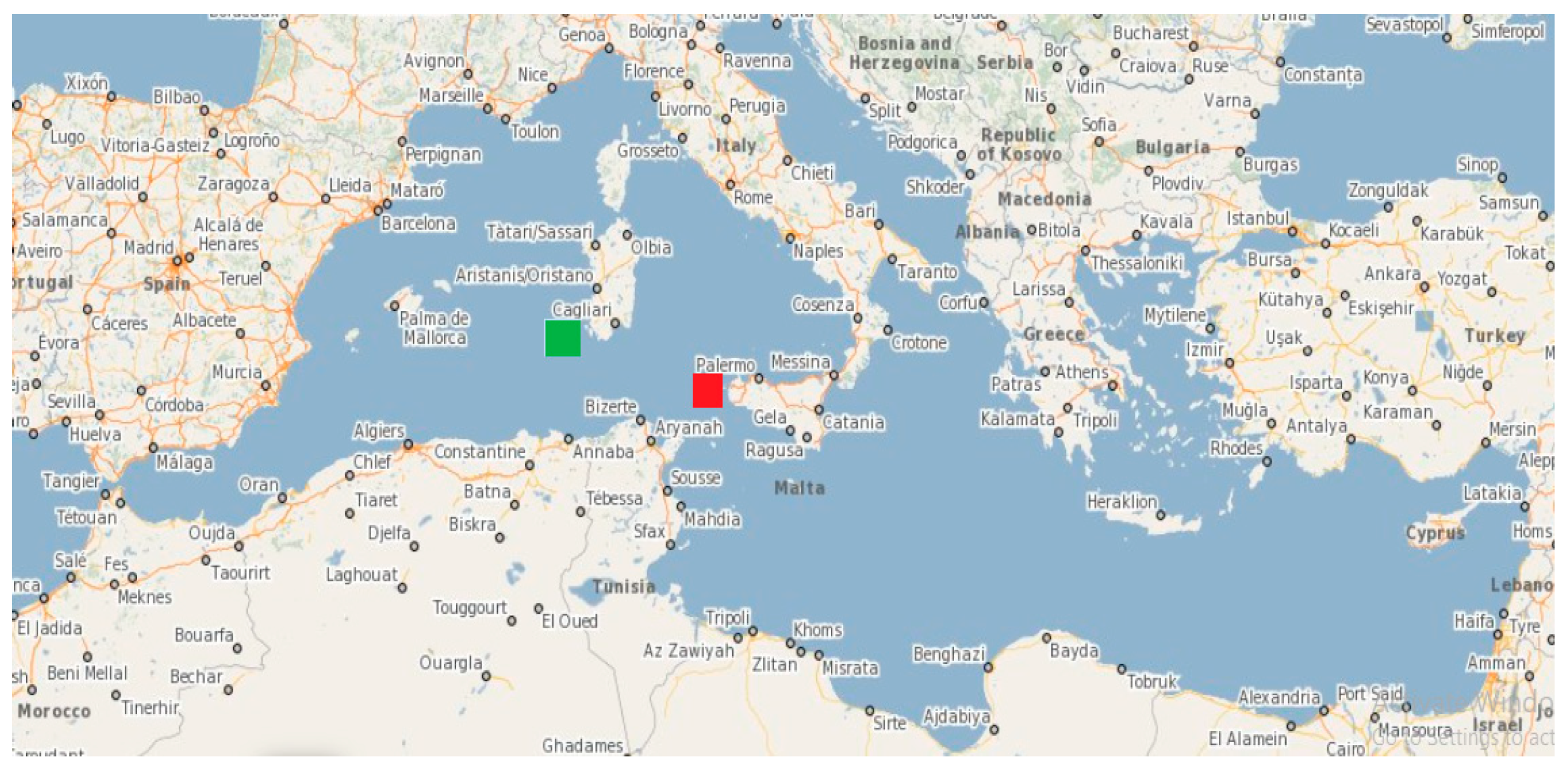
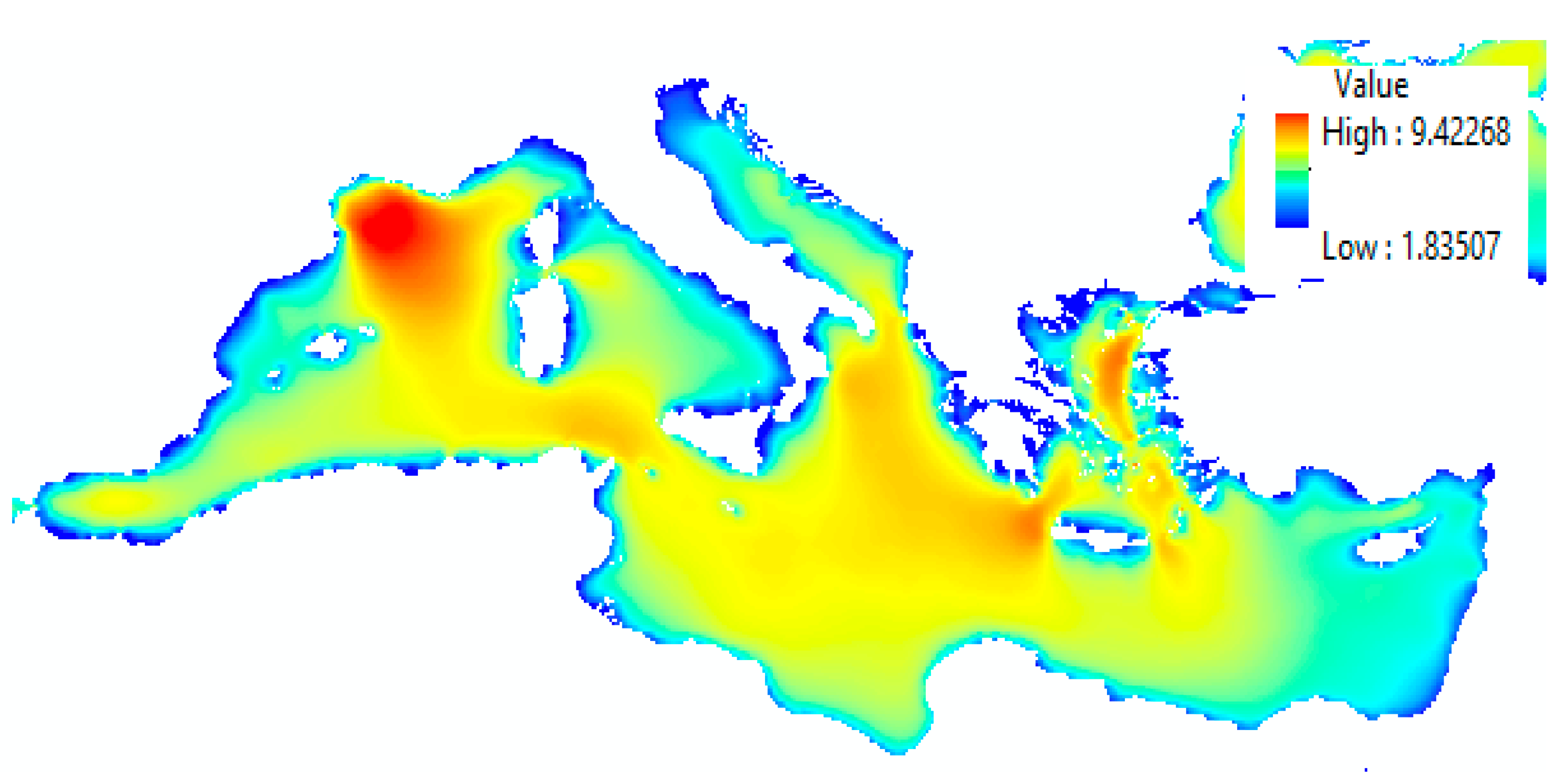
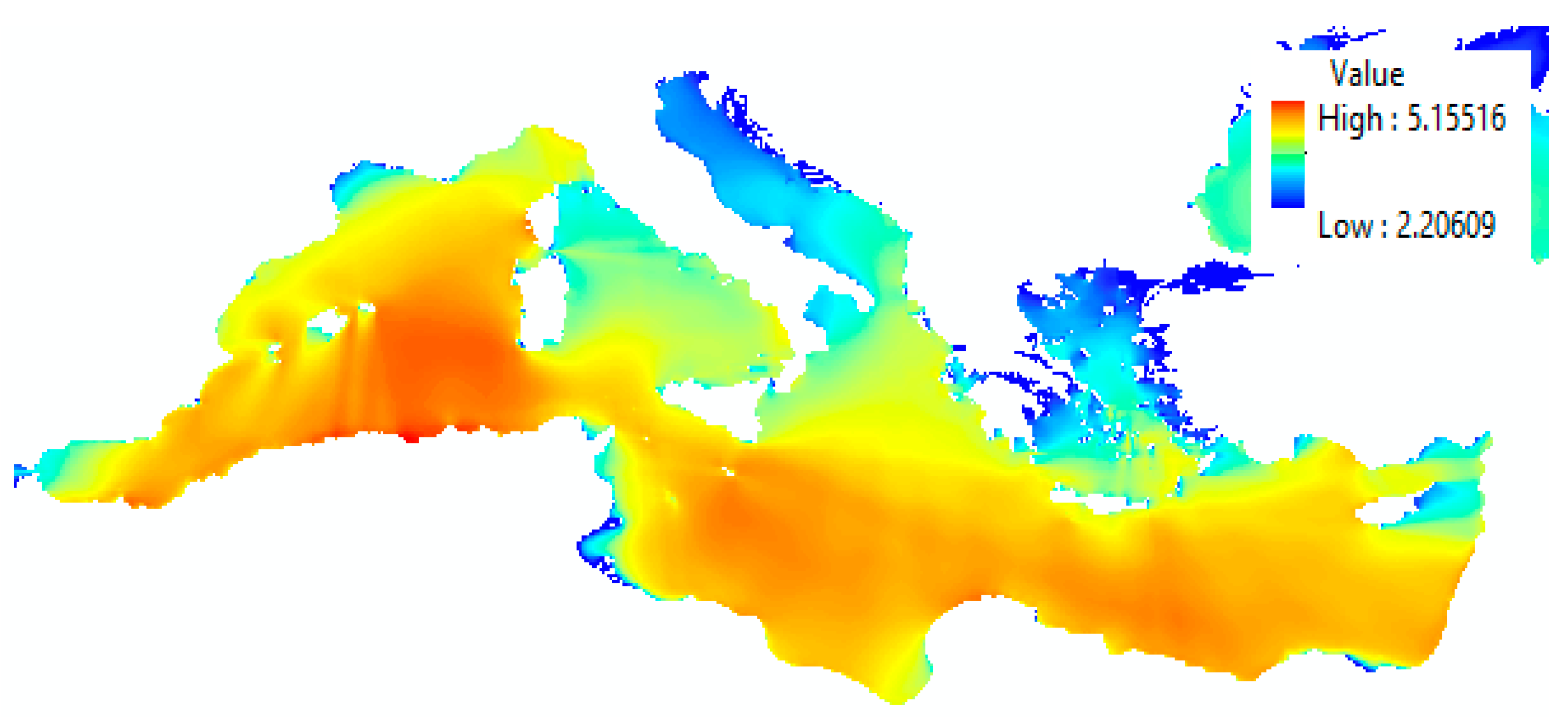
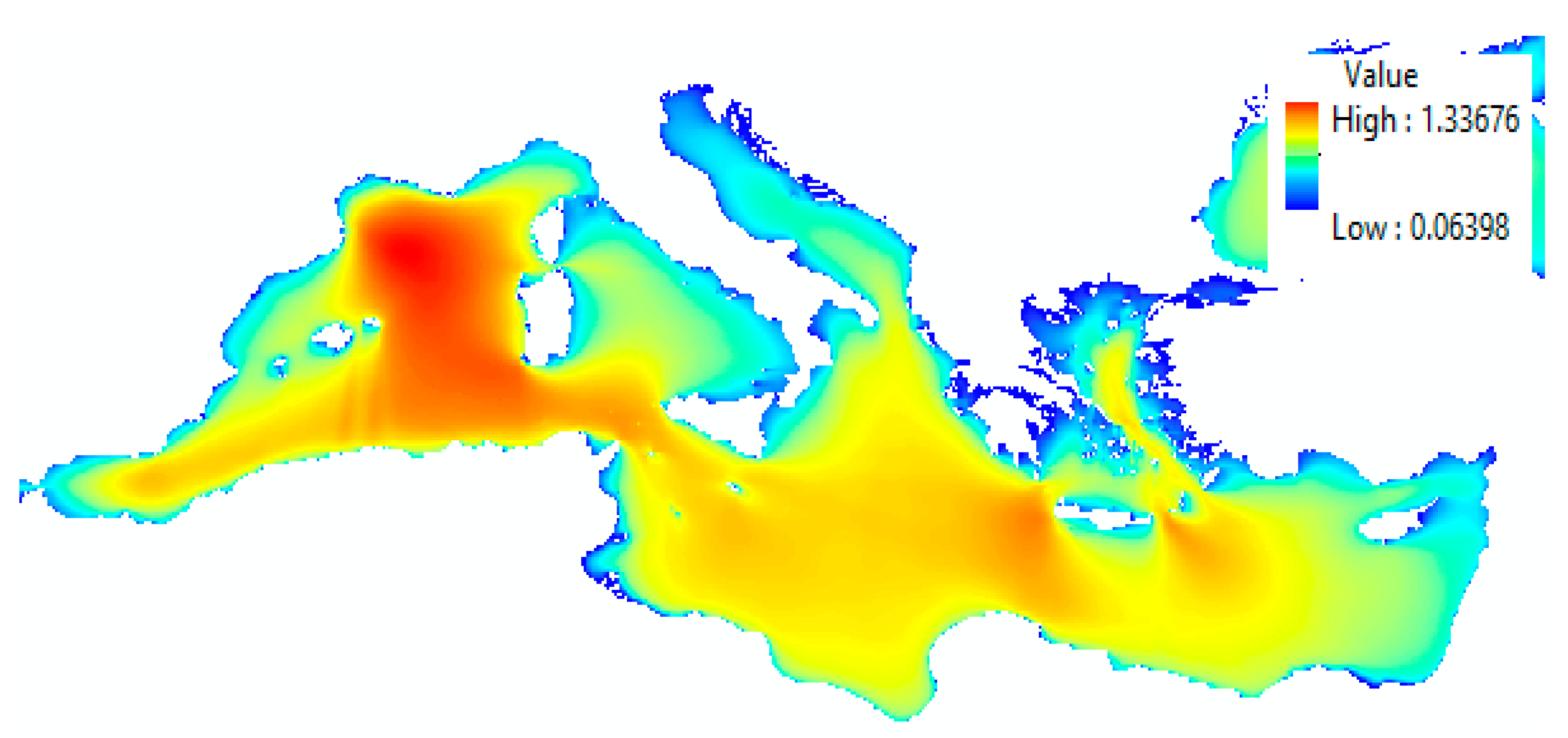
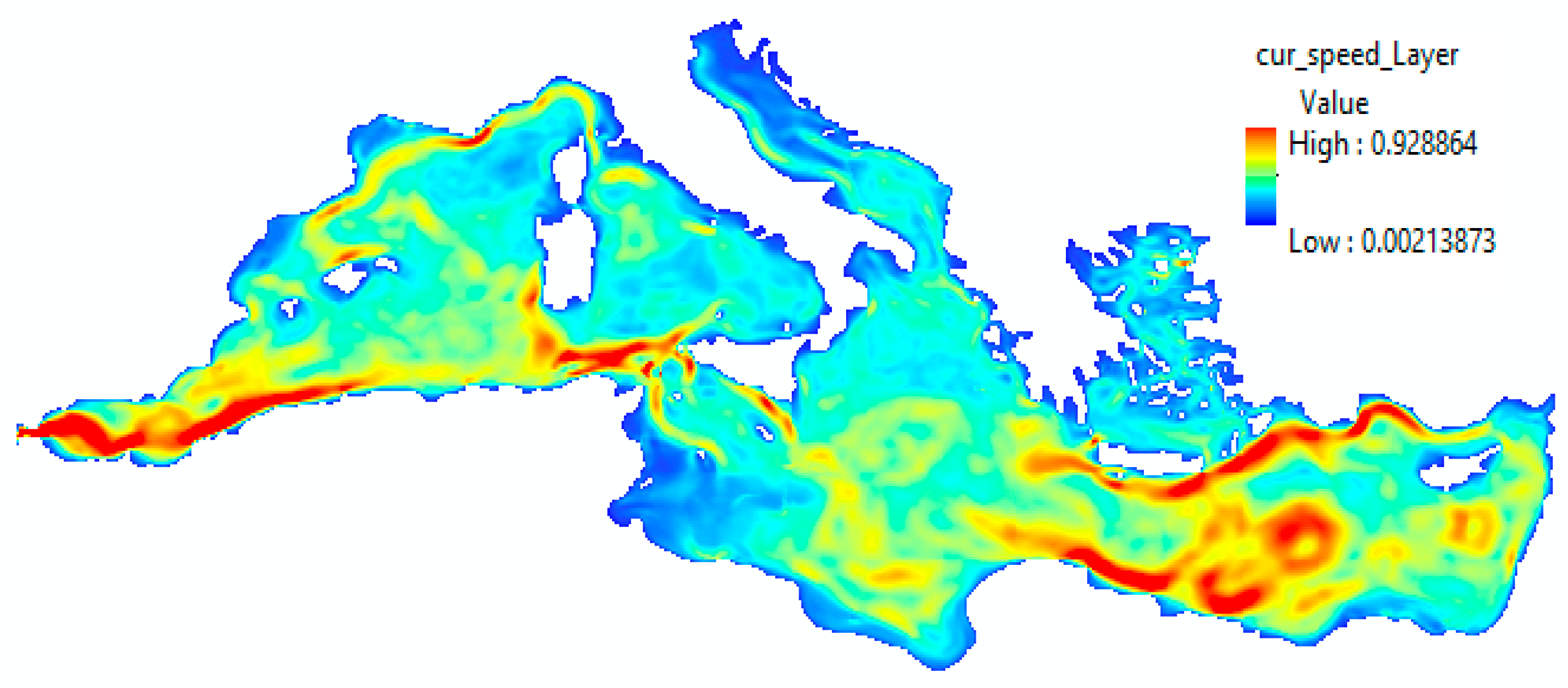
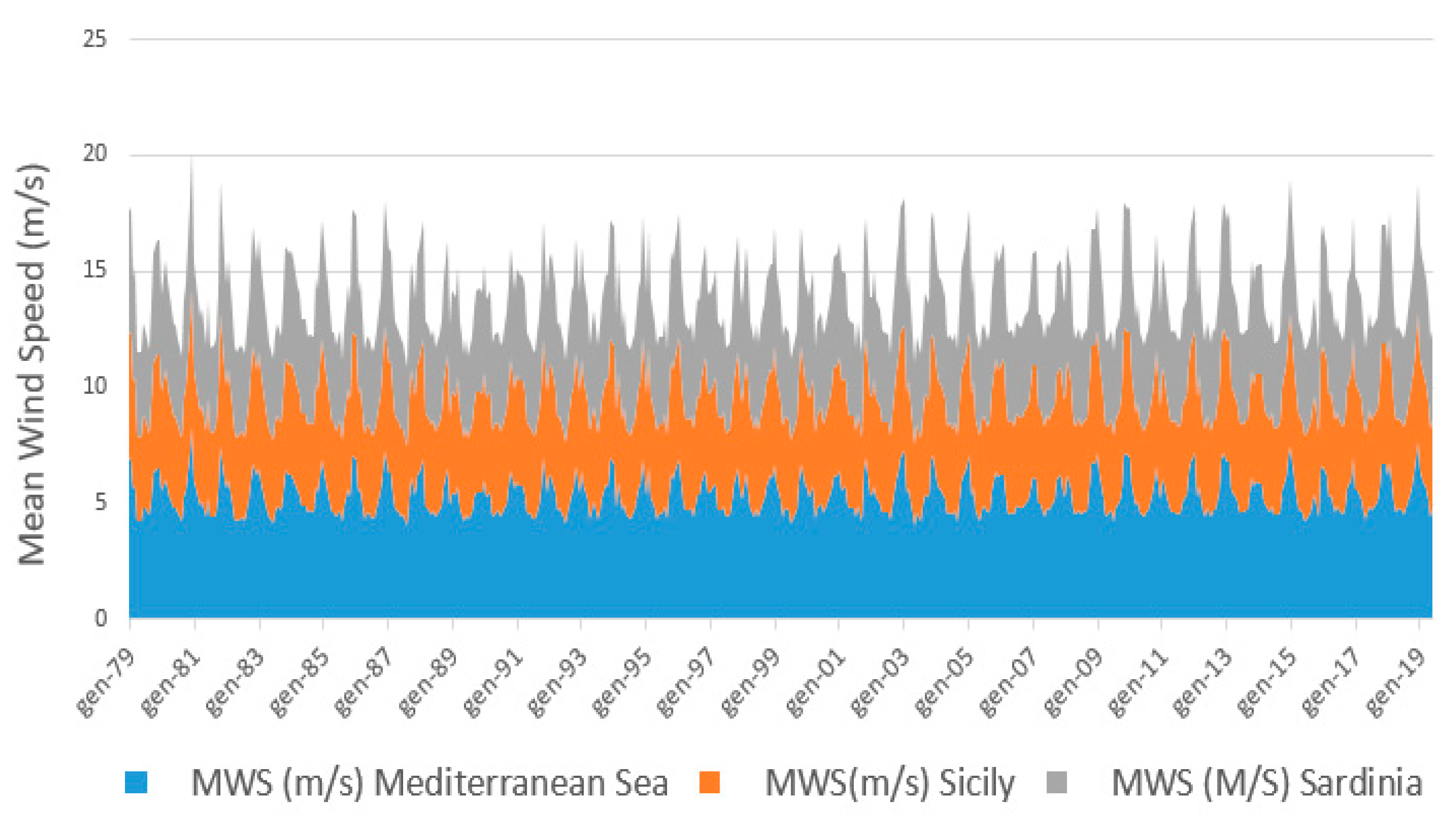
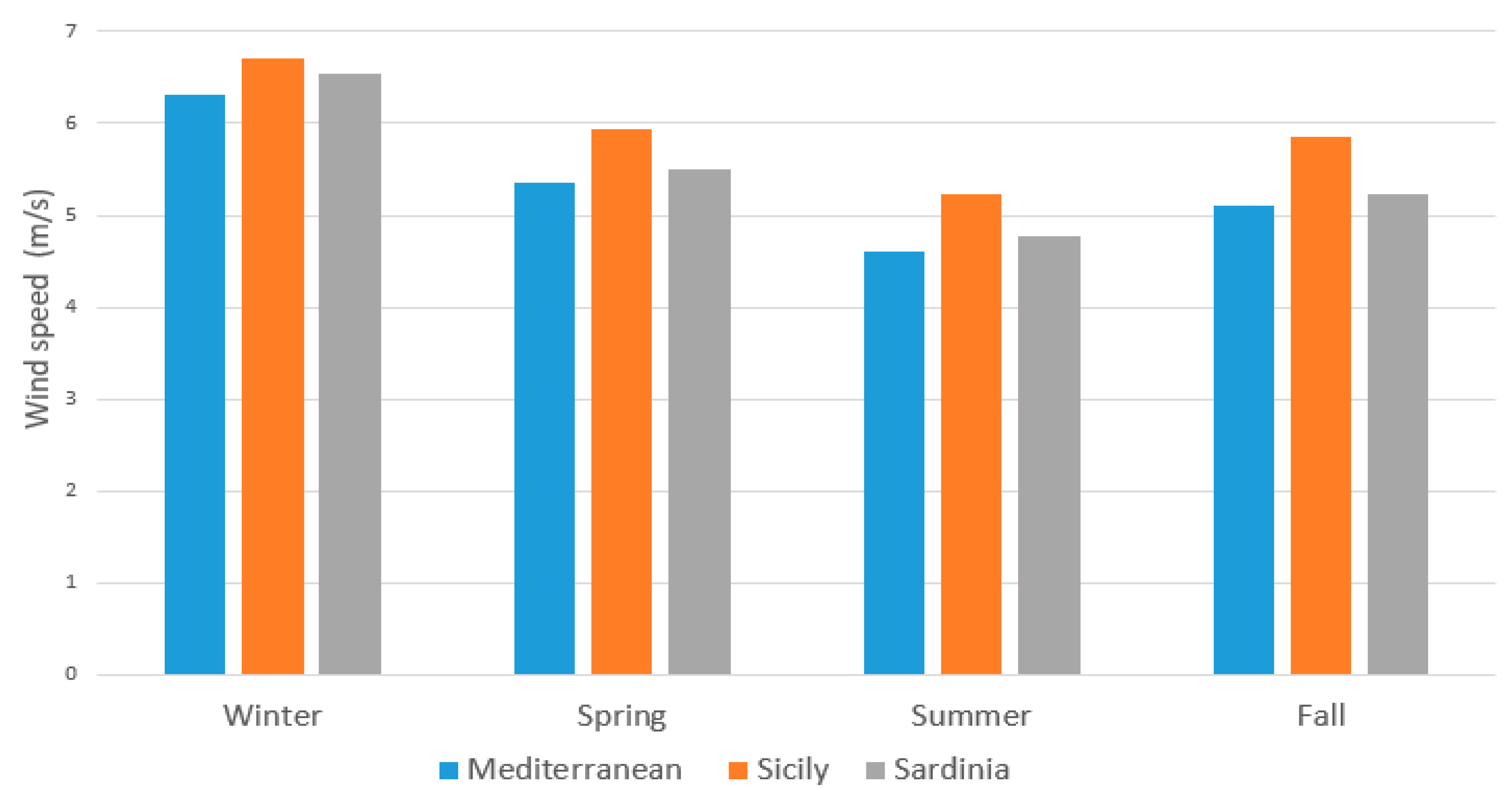
| Forces | Internal | External |
|---|---|---|
| Satellite Potential | Strengths | Opportunities |
| ESA and Italian Space Agency (ISA). Open access and unlimited policy support. Wind atlas mapping (wind industry). | Save time and money. Knowledge transfer from/to research centers and universities. A better understanding of forgotten areas of whole world (cover existing measurements gaps) | |
| Weaknesses | Threats | |
| The uniqueness of the available information due to the rotation of the satellite in the Earth’s orbit. | Specialized knowledge in various interdisciplinary fields. |
| Forces | Internal | External |
|---|---|---|
| Potential Assessment | Strengths | Opportunities |
| Marine large area observation. Find area with good geographic position and energy potentials (hot spot). | Better understanding of sources. Reduce strategic risk. Maximum use of susceptible areas. | |
| Weaknesses | Threats | |
| Sources estimation in Italy is incomplete. Incomplete measurable parameters. | Climate change. |
© 2020 by the authors. Licensee MDPI, Basel, Switzerland. This article is an open access article distributed under the terms and conditions of the Creative Commons Attribution (CC BY) license (http://creativecommons.org/licenses/by/4.0/).
Share and Cite
Majidi Nezhad, M.; Shaik, R.U.; Heydari, A.; Razmjoo, A.; Arslan, N.; Astiaso Garcia, D. A SWOT Analysis for Offshore Wind Energy Assessment Using Remote-Sensing Potential. Appl. Sci. 2020, 10, 6398. https://doi.org/10.3390/app10186398
Majidi Nezhad M, Shaik RU, Heydari A, Razmjoo A, Arslan N, Astiaso Garcia D. A SWOT Analysis for Offshore Wind Energy Assessment Using Remote-Sensing Potential. Applied Sciences. 2020; 10(18):6398. https://doi.org/10.3390/app10186398
Chicago/Turabian StyleMajidi Nezhad, Meysam, Riyaaz Uddien Shaik, Azim Heydari, Armin Razmjoo, Niyazi Arslan, and Davide Astiaso Garcia. 2020. "A SWOT Analysis for Offshore Wind Energy Assessment Using Remote-Sensing Potential" Applied Sciences 10, no. 18: 6398. https://doi.org/10.3390/app10186398
APA StyleMajidi Nezhad, M., Shaik, R. U., Heydari, A., Razmjoo, A., Arslan, N., & Astiaso Garcia, D. (2020). A SWOT Analysis for Offshore Wind Energy Assessment Using Remote-Sensing Potential. Applied Sciences, 10(18), 6398. https://doi.org/10.3390/app10186398









